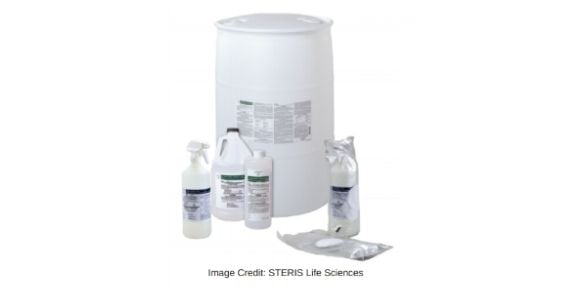Evaluating Employee Exposure to Spor-Klenz
For many years, a class of non-bleach liquid sporicidal disinfectants also known as cold sterilants, have been used throughout the biological research and pharmaceutical production industries to control microbial contamination on stainless steel, glass and plastic surfaces. These are made up of a stabilized mixture of peracetic acid, hydrogen peroxide and acetic acid. Spor-Klenz®, manufactured by STERIS Life Sciences is a popular example. These products are readily available as pre-mixed solutions or as a concentrate that requires dilution, usually a 100 times dilution (one part concentrate to 99 parts purified water).
Hazardous Components and Exposure Limits
The various commercially available mixtures contain different concentrations of hydrogen peroxide, acetic acid, and peracetic acid. It is important to note that acetic acid and hydrogen peroxide will react to form peracetic acid.
Peracetic acid (PAA) is a highly reactive, unstable, and peroxide-based molecule that is an oxidizer. It is corrosive and irritating to the eyes, skin, and mucous membranes. Inhaling PAA can cause coughing, shortness of breath, and pulmonary edema. OSHA has not established a permissible exposure limit (PEL) for PAA. The American Conference of Governmental Industrial Hygienists (ACGIH) has adopted a Threshold Limit Value (TLV®) of 0.4 ppm as a 15-minute short-term exposure limit (STEL).
In 2015, the National Institute for Occupational Safety and Health (NIOSH) published a draft immediately dangerous to life and health (IDLH) value for peracetic acid of 0.64 ppm. The agency has received public comments stating that the level is overprotective, and that the data available for peracetic acid are of low quality. NIOSH is currently re-evaluating the proposed IDLH value.
Hydrogen peroxide is a strong oxidizer, and extremely irritating to the eyes, skin, and mucous membranes. Signs and symptoms of exposure range from stinging and tearing of the eyes, to coughing, to pulmonary edema. OSHA, NIOSH, and ACGIH have set occupational exposure limits of 1 part per million (ppm) as a time-weighted average exposure limit.
Acetic acid, like hydrogen peroxide, is strongly irritating to the eyes, skin, and mucous membranes, and exposure results in similar symptoms. The odor threshold for acetic acid is reported to range from 0.48 ppm to 1 ppm, but should not be solely relied upon as a warning of potentially hazardous conditions. OSHA, NIOSH, and ACGIH have set 10 ppm as the allowable time-weighted average exposure limit. ACGIH and NIOSH have both adopted a 15-minute STEL for acetic acid of 15 ppm.
Evaluating Exposure
When evaluating employee exposure, it is important to sample for all three components. This can be a challenge. While there are NIOSH and OSHA methods for acetic acid and hydrogen peroxide, the sampling and analysis of PAA is difficult because it coexists with acetic acid and hydrogen peroxide, and neither NIOSH nor OSHA have published a sampling or analytical method for PAA. OSHA is currently working on a method for sampling PAA. Additionally, PAA and acetic acid have STELs which require short-term monitoring.
A method currently used for sampling peracetic acid was published in 2004 by the Institut National de Recherche et de Sécurité (INRS), the French research organization that is similar to our NIOSH.
The INRS method uses a sampling train that consists of a treated pre-filter for hydrogen peroxide, followed by a sorbent tube to collect peracetic acid and hydrogen peroxide simultaneously. Several AIHA-accredited labs provide this analysis. We recommend that you work with your laboratory to carefully review the sampling and analytical method in detail as you develop your sampling plan.
Control
Ventilation (engineering control) is the primary safeguard along with written procedures and training to minimize exposure. Personal protective equipment (PPE) to prevent eye, face and skin exposure to liquid or vapor should be appropriate for the use.
If engineering controls are not feasible to limit exposure to allowable limits, the use of respiratory protection may be necessary. Until recently, supplied air respiratory protection has been the general recommendation when working with hydrogen peroxide.
However, 3M has changed their recommendation from supplied air as the appropriate respirator system for hydrogen peroxide (H2O2). In 3M Technical Data Bulletin #185 - Respiratory Protection for Hydrogen Peroxide & Peracetic Acid, the 3M 6003 Organic Vapor/Acid Gas Cartridge and the 3M 6006 Multi-Gas/Vapor Cartridge are reported to be effective for 8 hours against H2O2 vapor concentrations up to approximately 90 ppm. Additionally, the bulletin reports that both acetic acid and peracetic acid vapors are removed effectively by 3M acid gas, organic vapor/acid gas, or multigas cartridges.
Of course, all use of respiratory protection should follow your institution's written respiratory protection program and occupational medicine programs.
Summary
An accurate evaluation of exposures to personnel working with cold sterilants such as Spor-Klenz© is essential to provide the information needed to recommend and provide proper worker safeguards. We are able to assist you in all aspects of recognizing, and controlling worker exposure to hazardous agents. Click the button below for more information about our EHS Consulting Services.
References:
Simultaneous Sampling of Peroxyacetic Acid and Hydrogen Peroxide in Workplace Atmospheres, The Annals of Occupational Hygiene, Volume 48, Issue 8, 1 November 2004, Pages 715–721
ACGIH. Documentation of the threshold limit values and biological exposure indices: peracetic acid. Cincinnati, OH: American Conference of Governmental Industrial Hygienists. 2017
3M Technical Data Bulletin #185 ― Respiratory Protection for Hydrogen Peroxide & Peracetic Acid Published: March, 2009






